With their GDO 20 green dot sight, Viridian Weapon’s Technologies has taken their many years of experience with green lasers and applied it to the reflex optic space. A green red-dot optic. It works, and it works great.
The advantage in a green dot over red is that human eyes see green far better than red. They’ve been making green laser devices and a wide range of electro-optics since 2006 based on this simple idea.
However much human eyes “see” green better, there’s no doubt the dot on the GDO 20 absolutely pops.
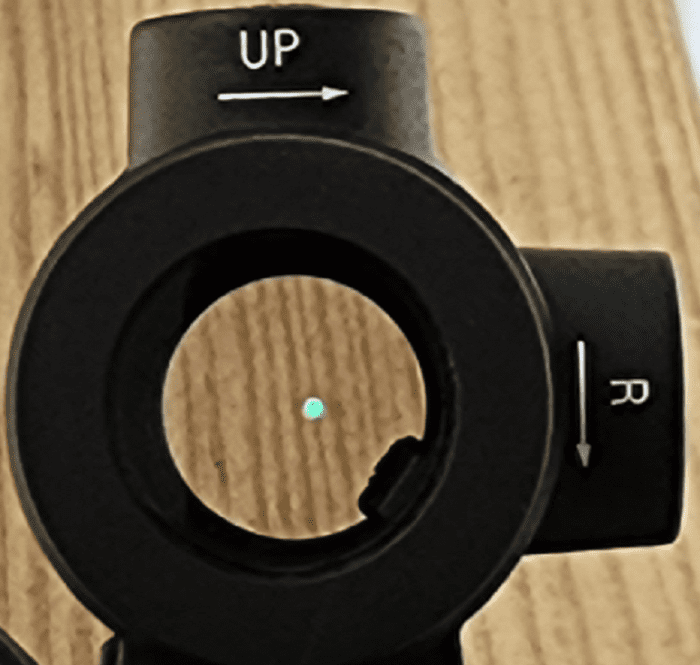
My astigmatism means there’s no such thing as a crisp dot, but other people tell me the GDO 20 is nice and sharp, and the images taken with my camera show a dot with fairly well defined borders. There’s no halo around the image in full sunlight, no matter how high up you turn the optic’s brightness, and there’s little to no bleeding of the edges either.

If there’s any bluing or false color in the optic, it is very mild. There may be a slight dimming of the image, but if there is, it’s very hard to tell. Looking through the optic as sunset fell here on my Texas Hill Country range, there was no target at 100 yards I could identify without the optic that I couldn’t also identify through the optic.
The GDO 20 isn’t very big. With only a 20mm objective, there’s not a whole lot of real estate inside the optic. Combined with a wide, flat ring around the objective and the emitter housing visible inside the image, you’re not going to get a big view of what’s around your target, especially if it’s in bright light and you turn the 3 MOA dot’s brightness all the way up.
There’s a price to pay for a small, compact 6.2oz form factor, and that price is a bit of situational awareness.
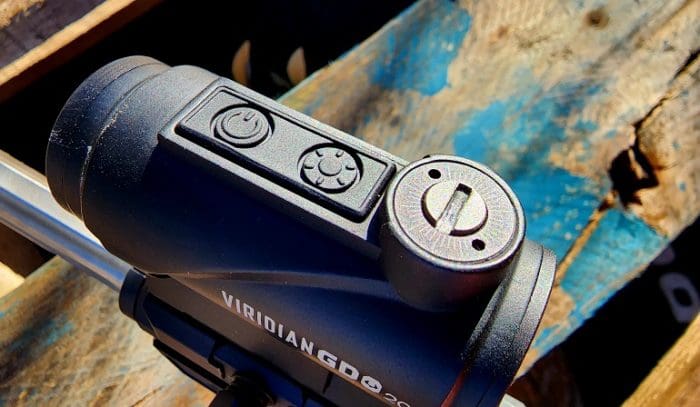
The GDO 20 has eight total brightness settings. Although Viridian advertises them as “7 visible and 1 night vision brightness settings,” they were all visible to me in a dark room.
The night vision setting works well enough. Through my AN/PVS14, the dot on the lowest setting was a little bit too bright in a completely dark room, and there was a definite, but transparent halo effect just around the dot. Still, I wouldn’t have any problems hammering pigs at 100 yards through the GDO 20 in front of NV optics.
If I have one complaint, it’s that maybe they’re right about the whole “eyes see green better” thing. The brightness settings are pretty bright. Even in the brightest daylight, the top two brightness levels were too much. At the Range at Austin’s indoor lanes, I kept hoping for a slightly dimmer setting for precision work, but there was an abrupt dropoff from “a bit too bright” to almost invisible.
There is no auto-brightness level. Brightness is controlled by two simple buttons on the top of the housing. They’re easy enough to manipulate with a bare hand, but they’re a little small and close together to operate with gloves on.

The GDO 20 runs on a single AAA battery (one is supplied) and Viridian’s specs state it will run for 30,000+ hours on a single battery at a middle brightness setting. I have no way to verify that number as that’s over 3 years time, but I can verify that it will sit on this setting or slightly higher for a full three months without being turned off, because that’s what I did.
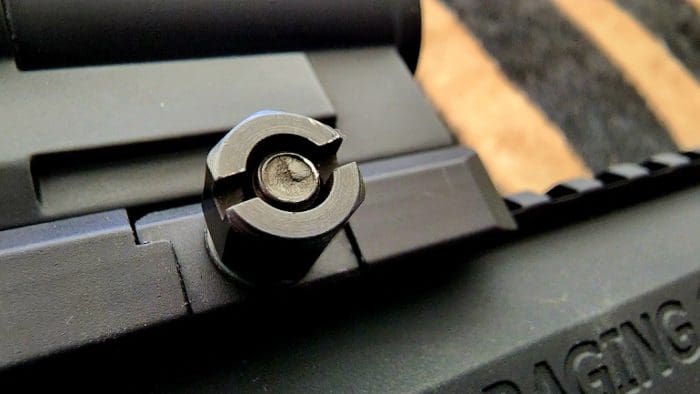
The included high Picatinny mount attaches with a single nut. This is a bit nit-picky, but Viridian didn’t get this quite right. The nut is slotted so that you can use a large screwdriver or other flat object to tighten the nut down. But once tightened down, the screw portion extends too far into the nut to use the slot.
If you don’t carry a socket into the field, any tightening or loosening of the optic now has to be done with whatever can be found, usually some sort of multi-tool, which mars the nut itself.
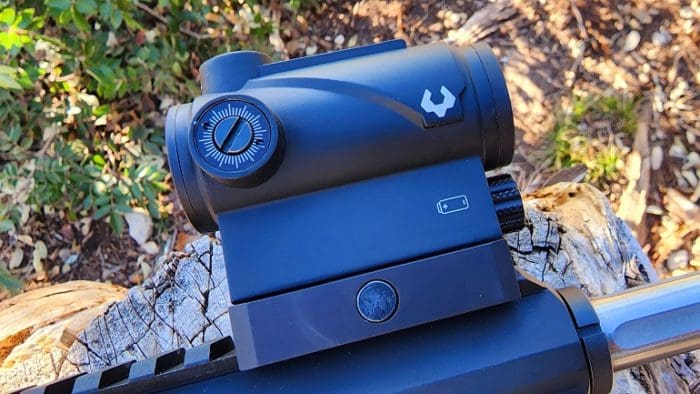
I’d like to see a QD mount offered, but the mount included on the GDO 20 works well. Once the nut was appropriately torqued down, it never budged, even under the stoutest recoil. It also sits at the right height to co-witness irons on an AR and should fit well in front of flip-away magnifiers.
I was a bit surprised at the IPX6 waterproof rating for the GDO 20. At this level of waterproofing, there’s very little danger of water damage being a problem, with the exception of prolonged dives in deep water. The actual standard for IPX6 is “can withstand high pressure, heavy sprays of water.” I swished it around in my bathtub and set it on the floor of the shower for a couple of days. Zero issues.

I now have zero concerns about the durability or reliability of the GDO 20. I ran the GDO 20 for part of my Palmetto State Armory AKV9 review and it worked great on that platform. However, the soft-recoiling 9mm AK variant wasn’t much of a test for the optic.
Enter the Taurus Raging Hunter in .460 S&W Magnum (review pending). Even with its obnoxious muzzle brake, there’s no getting around the recoil of a revolver pushing 360gr murder rocks at 1,800 fps (that’s a real chrono’d number).
I used the GDO 20 on top of the Raging Hunter in preparation for an upcoming safari. Despite a whole lot of truly punishing recoil, the GDO 20 never failed in any way. The “recoil management” box has been solidly checked.
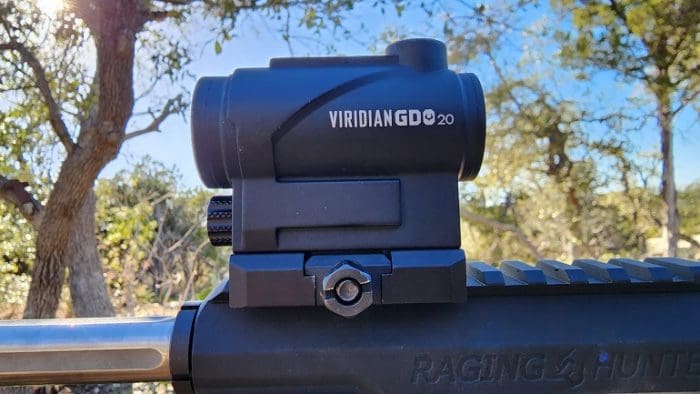
The Viridian GDO 20 has a lot to offer. Solid construction, light weight, easy controls, long battery life, a bright image and more from an American company that’s been around a while. It competes in an awfully crowded space, but it competes well.
The GDO 20’s feature set is pretty standard now, although it’s achieving that standard at a lower price than most of the other optics in its class. It’s that green dot on a “red dot” optic that really sets it apart.
Specifications: GDO 20 Green Dot Electro Optic
3 MOA Green Dot
20 mm objective lens
1 MOA windage and elevation turrets
7 Visible & 1 Night Vision Brightness Settings
ACTIVATION: Push-button
MOUNT: Picatinny high mount
BATTERY LIFE: 30,000+ hours (middle setting)
BATTERY TYPE: AAA
OBJECTIVE LENS: 20 mm
TOOLS: Included in packaging
MATERIALS: High-grade aluminum alloy
OP TEMP: -4 °F to 125 °F
WATERPROOF: IPX6
WEIGHT: 6.2oz
WARRANTY: 7 years
COUNTRY OF ORIGIN: Made in China
DOT SIZE:3 MOA
DOT COLOR: Green
OPTICAL ZOOM: 1x
MSRP: $259 (under $230 online)
Rating (out of five stars):
Overall * * * *
The Viridian GD0 20 is a solid performing reflex optic at a very reasonable price. The image is crisp and clear, the battery life is great, and it can take some serious recoil. I wish it were a bit bigger and had an auto-brightness feature, but as it is, this is a heck of a value.





If I were looking for a tubed green dot optic ‘comparison shopping’; Over this Veridan I’d choose the Sig Romeo 7S green dot, 2 MOA dot, with its motion wake up. Except for the 22 mm objective and the 2 MOA dot and it being about 1.5 ounces heavier and with 0.5 MOA click W/E adjustment, its more than comparable and has better glass and is also powered by a AAA battery and costs less ($177.99 on the Sig site).
Are any of the red / green dots made in America?
That’s a mixed bag Jeff.
Some are made (manufactured) in China its self like this Veridan. On the other hand, some are made (manufactured) in the U.S.A. like the Sig Romeo 7S (now, didn’t used to be – all the Sig Romeo line is now made in U.S.A).
But, all red/dots on the market have components that originated in China even if they are sold as “Made in U.S.A.”. If sold as ‘Made in U.S.A’ this is usually something like, for example, the (some) electronic components or maybe the W/E adjustment mechanism. The exception to this is the glass, it can be from a variety of sources but usually Europe or Japan or China, sometimes you see U.S. made glass.
For Made in U.S.A., the China origin parts are procured from an importer entity in the U.S. so the parts qualify under a loop hole in the law as ‘U.S. origin’ to claim ‘Made in U.S.A” so its ‘legally true’. Sometimes the China parts (or sometimes whole optics, Vertex does one of these) are made under contract and rebranded for the U.S. company then imported through an importer entity in the U.S. then procured from there to claim ‘Made in U.S.A’.
correction for : “(or sometimes whole optics, Vertex does one of these)”
Its not Vertex, its Crimson Trace. ‘sorry Vertex.
Vortex not vertex
duh….too many fingers on small phone key board and not paying attention.
.40 Cal,
You appear to be very up on the origins and manufacturing of optics.
In your opinion, with relations seemingly shifting with China, do you anticipate relocation of where optics components or even the whole unit are made?
maybe, but its not like these components can’t be produced anywhere else.
The advantage China has over everywhere else is price. They can turn out the stuff and supply it cheaper than others which is basically why, for example, every red dot manufacturer ends up using components to some extent that originate in China.
I’m always happy to see more green-dot optics.
Anyone who has avoided red dots due to astigmatism should give green dots a try. My astigmatism caused me to have to switch from red dots to green dots. Red dots now look fuzzy to my eyes, but green dots are perfectly clear and sharp!
But YMMV, your eyes (and your mileage) may vary.
Some manufacturers, such as Holosun and Eotech, charge more for their green dots than their red dots, so I’m also glad to see an inexpensive green dot.
a polarizing filter on a red dot takes care of the astigmatism issues for about 90% of people. Of course though, no one really makes one and it they do its usually the wrong size or shape for the red dot you have (one company makes one for their red dots, I forget the name right now). AimPoint used to supply one for their tubed red dots but they dropped it. I know people who make their own using polarizing film sheets, its easier for a tubed dot because you can usually get some covers and you cut out the center of one of the covers (usually on your end) and glue your filter in then you can rotate the cover to get the polarization angle right to do away with the astigmatism issue. Some people just use polarized glass to help.
To me, green looks just as fuzzy as red, and polarized glasses do nothing to help at all.
some people it doesn’t help with astigmatism, it helps about 90%. Astigmatism ‘types’ effects are different among people. And some people to whom it looks fuzzy don’t really have an astigmatism but rather another visual issue with focus or something else like, for example, a slowly developing Nearsightedness (myopia).
And sometimes its just old age creeping up on you. In our older ages sometimes we develop less sensitivity to light color in certain frequency ranges so small points of light in those color frequency ranges look fuzzier or dimmer.
And sometimes the problem with ‘polarizing’ is its not the right ‘polarizing’. The grating factor and grating angle orientation matter too so, for example, polarizing glasses/film may seem to work fine for other things but because of the way red dots work with the way they diffract the light they may not work for red dots because, for example, the grating or angle orientation of the grating may not be correct for red dot use.
correction: “diffract”
should have been: refract
That’s one thing I like about Cabelas. They have an extensive line of optics that you can see for yourself. I can’t buy online without first checking them out in person.
Silly question but do you know your weak eye strong eye? I can’t imagine polarized lenses don’t help you. Maybe someone can help with a customized polarized lense.
LASIK?
If turning down the dot brightness doesn’t clear up the issue some, and absent an issue with the sight its self causing the fuzzy look or an actual common astigmatism issue; Another vision issue with people seeing the dot either red or green as just ‘fuzzy/blurry’ (no star burst or separate dots types of things) is the possibility of a macular degeneration issue.
Basically;
The reason dots in Red Dot Sights (RDS) appear blurry or distorted or fuzzy to people with an astigmatism (not other vision issues) is because the dot is created in the view with a collimating minating mirror. This causes the light that creates the dot to be refracted into multiple multiple focal points. The result is a blurry, distorted or “bursting” or fuzzy dot. Polarized glasses/filters or the small hole in the BUIS (if you have those mounted) help to sharpen the dot because both devices restrict the light rays entering your eye to only those that are both direct and parallel with the other light rays, eliminating reflections and some of the additional focal points.
Holographic Weapon Sights (HWS) use a similar principal to red dots but uses different methods. One difference comes from the light bouncing off a “holographic grate” rather than into a single dot. For shooters with an astigmatism HWS dots can appear to have less distortion than a RDS because the holographic grate has a side effect of acting like a polarizing filer thus restricting the light rays entering your eye to only those that are both direct and parallel with the other light rays. But it is not true that HWS products are completely astigmatic aberration free.
Prism-based optics function more like traditional optics using lenses and etched glass to produce their reticles. Because of the lack of collimator or mirrors, most people with astigmatisms report less aberrations as compared to RDS or HWS systems.
I got a whole lot better after cataract surgery. Not perfect but I can generally see out to long distance. And mostly read with minimal reading glasses or none. Astigmatism about gone(I wore glasses until age 23). There’s hope in old age🙃
Another thing that helps is prescription glasses that correct for astigmatism. I have progressive transition lenses that have an oversized far vision area. I believe they are commonly referred to as “golfing glasses”. I just look through that area when I aim. That said, the glasses are not 100% effective, so I only use prism and conventional scopes.
its not just the color red either, it happens with green as well but some people who have the problem with the red dot do fine with a green dot. generally, if you are having problems with both colors you should consider seeing your eye doc and being examined as it could indicate another eye issue. also, people who drink alcohol or use pot a lot tend to sometimes have problems with both colors.
people with vitamin deficiencies can also see both colors, red and green, dots as fuzzy/blurry.
people who drink alcohol on a regular or heavy basis can have their color vision and other ares of vision affected, yes while not drinking alcohol or intoxicated. It can cause less sensitivity to red and green (and other) colors in some light frequency ranges making small areas of that color, in this case the dot in the sights, appear fuzzy/blurry or distorted. It can also cause decreased contrast sensitivity which can have the same effect for color vision OR trying to look at small things (like the dot), making them look fuzzy/blurry. Such alcohol use can also cause optic neuropathy (AKA ‘tobacco-alcohol amblyopia’, can happen to people who use tobacco too) which also affects color vision but this is more rare.
A nutritional deficiency can also affect vision and cause you to see small areas of color as fuzzy/blurry/distorted.
For fuzzy/blurry: One way to tell, or help indicate, if its really just an astigmatic issue or possibly another vision issue you may need to see a doc for, is using a ‘peep hole’ type sight (or hole) to look at the red/green dot. For example, if the sight is mounted on an AR put your rear BUIS on the rifle (or flip it up, if its not flip- up its already there, behind the dot optic and look at the dot through the smallest BUIS aperture hole. If it still looks fuzzy or blurry like it did without the peep hole, that could be related to another vision issue and you should get that possibility checked out with your medical professional.
If you do not have a BUIS you can substitute a piece of dark colored paper that is not the same color as the dot – put a small hole in it the same size as a BUIS aperture hole and look at the dot through that.
For other anomalies that are not fuzzy/blurry issues: Another test is simply rotating the sight. Dismount it from the firearm – hold it up to your eye about four inches away (or at your personal best focus point within a few inches of that four inches) and while looking at the dot rotate the sight a full 360 degree rotation about the center axis (your line of vision through the sight) – rotate in one direction only the first time (either clockwise or counter clockwise), then after a complete 360 degree rotation do the same but in the other direction for 360 degree rotation. If the dot does not shift position while you rotate the sight your issue is likely an astigmatism. If the dot seems to move position as you change the rotation of the sight the sight itself could be defective or experiencing problems or you possibly have another vision issue.
Do not assume that just fuzzy/blurry issues with the small dot, no matter the color, are simply astigmatism. It could be indicative of another vision issue developing for which you need medical attention or it could also indicate other non-vision medical issues such as, for example, circulatory or blood flow issues. Get it checked out by a medical professional to be sure.
here’s a pretty good video that explains astigmatism with these firearm optics pretty well.
https://www.youtube.com/watch?app=desktop&v=6CVXVwSH9uI
I read this part
The GDO 20 isn’t very big. With only a 20mm objective, there’s not a whole lot of real estate inside the optic. Combined with a wide, flat ring around the objective and the emitter housing visible inside the image, you’re not going to get a big view of what’s around your target. . .
There’s a price to pay for a small, compact 6.2oz form factor, and that price is a bit of situational awareness.
I was about to make a snarky comment about how the author needed to learn how to shoot an optic like this. Both eyes open with the optic actually taking up just a minuscule part of his field of view.
Then I saw JWT wrote this article. I’m confused. Because his statement still doesn’t make sense.
With both eyes open and the optic way out at the front end of the upper receiver, you could put lens covers on the optic. and still not have it impact situational awareness.
Maybe in theory, put in reality that’s not the case. If you’re going to focus quickly on that dot sitting on top of your target, the more obstructions that exist around that dot, the less situational awareness you’ll have for what’s right around your target. For this optic, I shot it side by side with a 28 mm objective versus this 20 mm objective, and the difference was really obvious, even with both eyes open.
“Made in China” = “never. “
“I only eat 100 percent gradeA beef!” – says Dave, speaking to someone on his Chinese smartphone while seated at McDonald’s
That revolver is obscene. I want one!
Comments are closed.